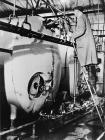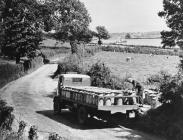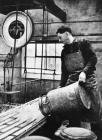Milk factories at Pont Llanio & Felinfach
Items in this story:
Historical background
In the closing years of the nineteenth century, there were many inefficiencies in the milk industry despite the strong presence in the county of the agricultural co-operative societies. Because of poor exploitation of transport facilities, milk output in mid-Cardiganshire went to the production of butter and cream instead of the then more profitable liquid milk market. For example, in 1896 a small milk factory was built at Pont Llanio railway station, at the instigation of the newly formed County Council, for making butter and related products but little attempt was made to take advantage of the railway other than as a local transport link.
Following a sharp decline in the Cardiganshire dairying industry in the early twentieth century, co-operative societies encouraged and achieved a revival during the 1920s and even experimented with the marketing of liquid milk. Despite the availability of milking machines, few farmers were able to afford the capital equipment which would have brought about considerably greater productivity; as late as 1939 only 8% of the dairy herds in England and Wales were machine-milked, and in Cardiganshire fewer than 15% of farms had access to an electricity supply.
The Milk Marketing Board
It was not until the establishment of the MMB in 1933 that milk collection, distribution and marketing began to be carried out in a more organised way and on a greater scale than hitherto.The Cardiganshire farming economy became increasingly based on milk production from the 1930s and following local pressure, improvements made by the MMB included the introduction of zoning of farms and collection points in order to reduce transport costs and the construction of a rail-connected depot to serve the northern zone at Pont Llanio.
The new factory was opened on the 1 October 1937, and was eventually equipped for handling liquid milk, milk separation, butter-making and powdered skimmed milk production. By 1950, intake was 136,200 litres (30,000 gallons) per day, a very high figure, requiring the employment of over 120 staff and 24-hour working in the summer months.
A new factory at Felinfach
The success of milk production in the area, despite a nationwide decline in consumption at the time, prompted construction of a new factory in 1951, known as Felinfach and only 13km (8 miles) from Pont Llanio. Situated at Green Grove on the Lampeter to Aberayron branch railway, which was then on the point of closure, it became a major producer of butter, dried milk (taking over these functions from Pont Llanio) and buttermilk in addition to liquid milk. In 1956, in spite of national milk sales at their lowest since before World War II, the factory was enlarged to give a capacity for processing 113,500 litres (25,000 gallons) of milk daily. By 1966, Cardiganshire was producing the considerable total of 92.6 million litres (20.4 million gallons) of milk a year (an average of 253,740 litres [55,890 gallons] daily), however, rationalisation of processing facilities led to the decline of Pont Llanio, which was handling only 45,400 litres (10,000 gallons) daily with just 32 staff by 1969. Following a strike by lorry drivers, Pont Llanio factory and its rail link closed in September 1970. The milk intake and some of the staff were then transferred to Felinfach.
Collecting milk from farms
Milk was collected daily, twice daily in summer, by lorry from farms in the Pont Llanio 'zone'. It was collected in standard, aluminium 45 litre (10 gallon) churns which were left, labelled with the farmer’s details, on small roadside platforms or milk-stands. Some milk-stands were of quite elaborate design (see above), and others extremely basic, although all were built to standard dimensions set by the MMB.
Churns full of milk are heavy items, so to load them onto a lorry they had to be standing at the height of the lorry decking and in a position where the lorry could get alongside. They also needed shade and the platform needed to be large enough to allow the driver to unload as many empty churns onto the platform as he had to collect.
Eventually new regulations changed the way milk was transported, and the churn stands went out of use almost overnight, as tankers were introduced to collect the milk directly from refrigerated storage tanks in the farm dairy.
Many of these stands survive having largely been unnoticed over the last forty years or so. Some will have been reused for different purposes. The Yorkshire Dales National Park Authority has collected many photographs taken by volunteers of these milk-stands, relics of the equivalent dairy industry there. Follow the link: http://www.yorkshiredales.org.uk/index/learning_about/historic-environment/fos/churn_stands_main.htm
Factory operation & process
On arrival at the Pont Llanio factory, lorries were unloaded at the covered platform or 'deck' as it was known. The churns were weighed, contents checked (by appearance, smell and temperature) and emptied into a receiving tank. Immediately, churns were steam sterilised and loaded back onto a waiting lorry for return to the farms. Prior to 1951, at Pont Llanio, milk for onward transport by rail was cooled and pumped to a large cylindrical output tank above the railway siding. Milk for further processing was pumped to a separator and split into cream and skimmed milk. The former was used for butter-making, stored in a refrigerated room pending transport, and the skimmed milk, more suitable than full-fat milk, was converted to powder by spray-drying, the steel-framed tower containing equipment for this process. Because of the large workforce, a canteen was provided on the first floor alongside the administration offices. Coal for the boilers was brought in by rail.
In the early years, liquid milk was loaded into 13,620 litre (3,000 gallon) glass-lined rail tank wagons which were collected by up passenger trains and taken to Carmarthen for attachment to trains for London. Empty wagons were left on the short siding on the north of the building and moved into position below the output tank by means of fixed capstan winches. The MMB leased the south siding for import of coal but also for facilitating the marshalling of empty and full milk wagons. When the Felinfach milk factory was opened, rail tanker traffic from the two factories was combined at Lampeter. During the gradual decline of services and closure of the railways north of Pont Llanio and west of Felinfach, both were served by up to three dedicated trains a day, involving complex workings by steam locomotives from Carmarthen and later class 35 and 37 diesel motive power from as far away as Landore, Swansea.
A network of creameries
The factory at Pont Llanio was part of a network of creameries throughout the main west Wales milk-producing region. Within Cardiganshire were the Dried Milk Products cheese-making factory at Newcastle Emlyn (shown above), which opened in the former town workhouse in 1920 and closed in 1983; Llanybydder Cooling Centre; Tivyside Creameries' butter-making factory at Capel Dewi; the Butter Factory at Lampeter, closed in 1927, and Felinfach factory as described above. In addition there were smaller dairies, e.g. at Lampeter and Bronant.
Outside the county there was Carmarthen's United Dairies liquid milk distribution depot, a Farmers Mutual Society, which is thought to have opened before the 1930s and operated until 1967/9. There was also Whitland's butter, milk powder and butter-packing factory which closed in 1994, and the hard-cheese factory at Johnstown to the west of Carmarthen, which closed in 1986, although a new creamery was later built to the south by St. Ivel Ltd.
Other factories included the butter-making factory on Station Road, St Clears and Merlins Bridge Creamery, Haverfordwest, which opened in 1930 and is still in operation, now known as the Pembrokeshire Cheese Company.
Story contributed by RCAHMW





